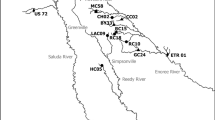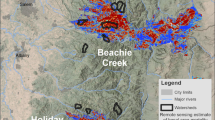Abstract
We documented valley and channel characteristics and wood loads in 19 reaches of forested headwater mountain streams in the Bighorn National Forest of northern Wyoming. Ten of these reaches were in the Upper Tongue River watershed, which has a history of management including timber harvest, tie floating, and road construction. Nine reaches were in the North Rock Creek watershed, which has little history of management activities. We used these data to test hypotheses that (i) valley geometry correlates with wood load, (ii) stream gradient correlates with wood load, and (iii) wood loads are significantly lower in managed watersheds than in otherwise similar unmanaged watersheds. Statistical analyses of the data support the first and third hypotheses. Stream reaches with steeper valley side slopes tend to have higher wood loads, and reaches in managed watersheds tend to have lower wood loads than reaches in unmanaged watersheds. Results do not support the second hypothesis. Shear stress correlated more strongly with wood load than did stream gradient, but statistical models with valley-scale variables had greater explanatory power than statistical models with channel-scale variables. Wood loads in stream reaches within managed watersheds in the Bighorn National Forest tend to be two to three times lower than wood loads in unmanaged watersheds.








Similar content being viewed by others
References
Andrus CW, Long BA, Froehlich HA (1988) Woody debris and its contribution to pool formation in a coastal stream 50 years after logging. Canadian Journal of Fisheries and Aquatic Sciences 45:2080–2086
Avery TE, Burkhart HE (2002) Forest measurements. McGraw-Hill, New York
Bilby RE, Likens GE (1980) Importance of organic debris dams in the structure and function of stream ecosystems. Ecology 61:1107–1113
Chamberlin TW, Harr RD, Everest FH (1991) Timber harvesting, silviculture, and watershed processes. In: Meehan WR (ed) Influences of forest and rangeland management on salmonid fishes and their habitats. American Fisheries Society Special Publication 19:181–205
Comiti F, Andreoli A, Mao L, Lenzi MA (2008) Wood storage in three mountain streams of southern Andes and its hydro-morphological effects. Earth Surface Processes and Landforms 33:244–262
Crowley PD, Reiners PW, Reuter PW, Kaye GD (2002) Laramide exhumation of the Big Horn Mountains, Wyoming: an apatite (U-Th)/He thermochrology study. Geology 30:27–30
Curran JH, Wohl EE (2003) Large woody debris and flow resistance in step-pool channels, Cascade Range, Washington. Geomorphology 51:141–157
Davis LS, Johnson KN (1987) Forest management. McGraw-Hill, New York
Fausch KD, Northcote TG (1992) Large woody debris and salmonid habitat in a small coastal British Columbia stream. Canadian Journal of Fisheries and Aquatic Sciences 49:682–693
Fausch KD, Young MK (2004) Interactions between forests and fish in the Rocky Mountains of the USA. In: Northcote TG, Harman GF (eds) Fishes and forestry: worldwide watershed interactions and management. Blackwell Science, Oxford, UK, pp 463–484
Faustini JM, Jones JA (2003) Influence of large woody debris on channel morphology and dynamics in steep, boulder-rich mountain streams, western Cascades, Oregon. Geomorphology 51:187–205
Granum RM (1990) History of the Tongue River tie flume, Big Horn Mountains, 1893–1913. Library Foundation, Sheridan County, WY
Gurnell AM (2003) Wood storage and mobility. American Fisheries Society Symposium 37:75–91
Hassan MA, Hogan DL, Bird SA, May CL, Gomi T, Campbell D (2005) Spatial and temporal dynamics of wood in headwater streams of the Pacific Northwest. Journal of the American Water Resources Association 41:899–919
Jackson CR, Sturm CA (2002) Woody debris and channel morphology in first- and second-order forested channels in Washington’s coast ranges. Water Resources Research 38:1177
Jones JA, Grant GE (1996) Peak flow responses to clear-cutting and roads in small and large basins, Western Cascades, Oregon. Water Resources Research 32:959–974
Keller EA, Swanson FJ (1979) Effects of large organic material on channel form and fluvial processes. Earth Surface Processes 4:361–380
Lienkaemper GW, Swanson FJ (1987) Dynamics of large woody debris in streams in old-growth Douglas-fir forest. Canadian Journal of Forest Research 17:150–156
Lowham HW (1988) Streamflows in Wyoming. U.S. Geological Survey Water-Resources Investigations Report 88–4045
Marcus WA, Marston RA, Colvard CR, Gray RD (2002) Mapping the spatial and temporal distributions of woody debris in streams of the Greater Yellowstone Ecosystem, USA. Geomorphology 44:323–335
Mead E (1899) Water-rights problems of the Big Horn Mountains. U.S. Geological Survey Water-Supply Paper 23
Meyer CB, Knight DH, and Dillon GK (2005) Historic range of variability for upland vegetation in the Bighorn National Forest, Wyoming. USDA Forest Service General Technical Report RMRS-GTR-140
Montgomery DR, Buffington JM (1997) Channel-reach morphology in mountain drainage basins. Geological Society of America Bulletin 109:596–611
Montgomery DR, Buffington JM, Smith RD, Schmidt KM, Pess G (1995) Pool spacing in forest channels. Water Resources Research 31:1097–1105
Moulton C (1995) Roadside history of Wyoming. Mountain Press, Missoula, MT
Opperman JJ (2005) Large woody debris and land management in California’s hardwood-dominated watersheds. Environmental Management 35:266–277
Ott RL, Longnecker M (2001) Statistical methods and data analysis. 5th ed. Duxbury, Pacific Grove, CA
Richmond AD, Fausch KD (1995) Characteristics and function of large woody debris in subalpine Rocky Mountain streams in northern Colorado. Canadian Journal of Fisheries and Aquatic Sciences 52:1789–1802
Robison EG, Beschta RL (1990) Characteristics of coarse woody debris for several coastal streams of south-east Alaska, USA. Canadian Journal of Fisheries and Aquatic Sciences 47:1684–1693
SAS Institute Inc (2003) SAS 9.1 qualification tools user’s guide. SAS Institute Inc., Cary, NC
Sedell JR, Leone FN, Duval WS (1991) Water transportation and storage of logs. American Fisheries Society Special Publication 19:325–368
Swanson FJ, Bryant MD, Lienkaemper GW, Sedell JR (1984) Organic debris in small streams, Prince of Wales Island, southeast Alaska. USDA Forest Service, Pacific Northwest Forest and Range Experiment Station, General Technical Report PNW-166
Takacs A, Vogel JL, Corrigan P, Gillette S (1995) A climatic analysis of orographic precipitation over the Big Horn Mountains. NOAA Technical Memorandum NWS HYDRO 46
Tinker DB, Resor CAC, Beauvais GP, Kipfmueller KF, Fernandes CI, Baker WL (1998) Watershed analysis of forest fragmentation by clearcuts and roads in a Wyoming forest. Landscape Ecology 13:149–165
Webb AA, Erskine WD (2003) Distribution, recruitment, and geomorphic significance of large woody debris in an alluvial forest stream: Tonghi Creek, southeastern Australia. Geomorphology 51:109–126
Wemple BC, Swanson FJ, Jones JA (2000) Forest roads and geomorphic process interactions, Cascade Range, Oregon. Earth Surface Processes and Landforms 26:191–204
Winters DS, Bohn B, Peterson D, Plume D, Quimby CM, Scaife D, Staley DM (2004) Aquatic, riparian, and wetland ecosystem assessment for the Bighorn National Forest. Report 2 of 3: Anthropogenic influences report. USDA Forest Service, Rocky Mountain Region, Denver, CO
Wohl E, Jaeger KL (2008) Longitudinal distribution of wood and wood jams along headwater streams in the Colorado Front Range. Earth Surface Processes and Landforms (in press)
Wolman MG (1954) A method of sampling coarse river-bed material. EOS, Transactions American Geophysical Union 35:951–956
Young MK, Haire D, Bozek MA (1994) The effect and extent of railroad tie drives in streams of southeastern Wyoming. Western Journal of Applied Forestry 9:125–130
Young MK, Mace EA, Ziegler ET, Sutherlan EK (2006) Characterizing and contrasting instream and riparian coarse wood in western Montana basins. Forest Ecology and Management 226:26–40
Zelt RB, Wohl EE (2004) Channel and woody debris characteristics in adjacent burned and unburned watersheds a decade after wildfire, Park County, Wyoming. Geomorphology 57:217–233
Acknowledgments
This project was funded through the USDA Forest Service Region 2 Fish Habitat Relationship program. We thank David Winters for facilitating funding and providing useful input to study design. Dan Scaife of the Bighorn National Forest also provided salary support for A. L. Nowakowski. Will Young, Chris Thomas, Megan Smith, Mary Honer, Kathy Kennedy, David Anderson, Dennis Staley, Sara Rathburn, Brian Bledsoe, Francesco Comiti, and Becky Orsi provided technical assistance with data acquisition or analysis, and Becky Imdieke provided field assistance. Two anonymous reviewers provided helpful suggestions for revising the manuscript.
Author information
Authors and Affiliations
Corresponding author
Rights and permissions
About this article
Cite this article
Nowakowski, A.L., Wohl, E. Influences on Wood Load in Mountain Streams of the Bighorn National Forest, Wyoming, USA. Environmental Management 42, 557–571 (2008). https://doi.org/10.1007/s00267-008-9140-4
Received:
Revised:
Accepted:
Published:
Issue Date:
DOI: https://doi.org/10.1007/s00267-008-9140-4




